Abstract
High levels of polynuclear aromatic hydrocarbon (PAH) carcinogens commonly occur in aquatic systems where neoplasms arise in fish and other animals. Enzymes that transform PAHs can act in initiating these diseases and can indicate the contamination of fish by carcinogens and other pollutants. Cytochrome P-450 has similar roles in activating PAH carcinogens in fish and mammalian species. PAHs and many chlorinated hydrocarbons, e.g., polychlorinated biphenyls (PCBs) induce a form of cytochrome P-450 in fish that is the primary catalyst of PAH metabolism. The induction of this P-450 in fish can accelerate the disposition of hydrocarbons, but can also enhance the formation of carcinogenic derivatives of PAHs. Invertebrates have lower rates of PAH metabolism than fish. These rates are not obviously inducible by exposure to PAHs or PCBs. The lower rates of foreign compound metabolism contribute to higher pollutant residue levels in bivalve mollusks (clams, mussels, etc.) than in fish and may limit the involvement of some procarcinogens (requiring activation) in disease processes in invertebrates. The induction of P-450 forms can indicate the exposure of fish to PAHs, PCBs, and other toxic compounds. This is not restricted to carcinogens. Environmental induction has been detected in fish from contaminated areas by use of catalytic assay, antibodies to fish P-450, and cDNA probes that hybridize with P-450 messenger RNA. Application of these methods can provide sensitive biological monitoring tools that can detect environmental contamination of fish by some carcinogens and tumor promoters.(ABSTRACT TRUNCATED AT 250 WORDS)
Full text
PDF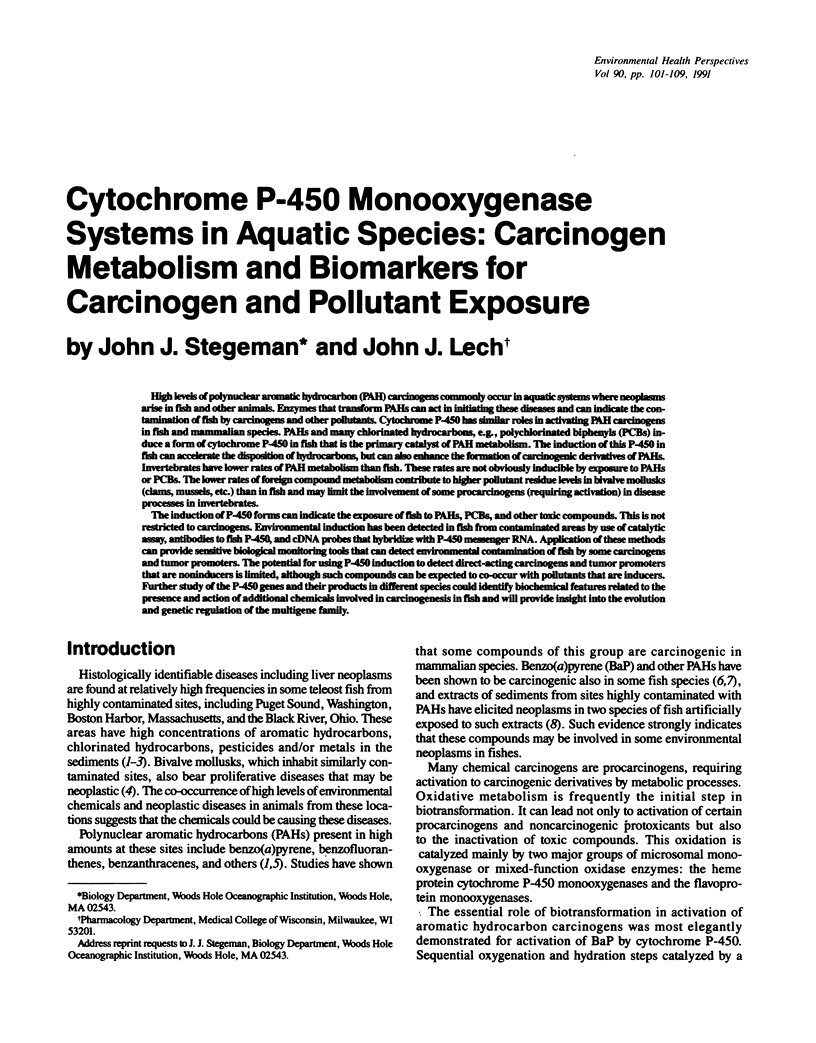
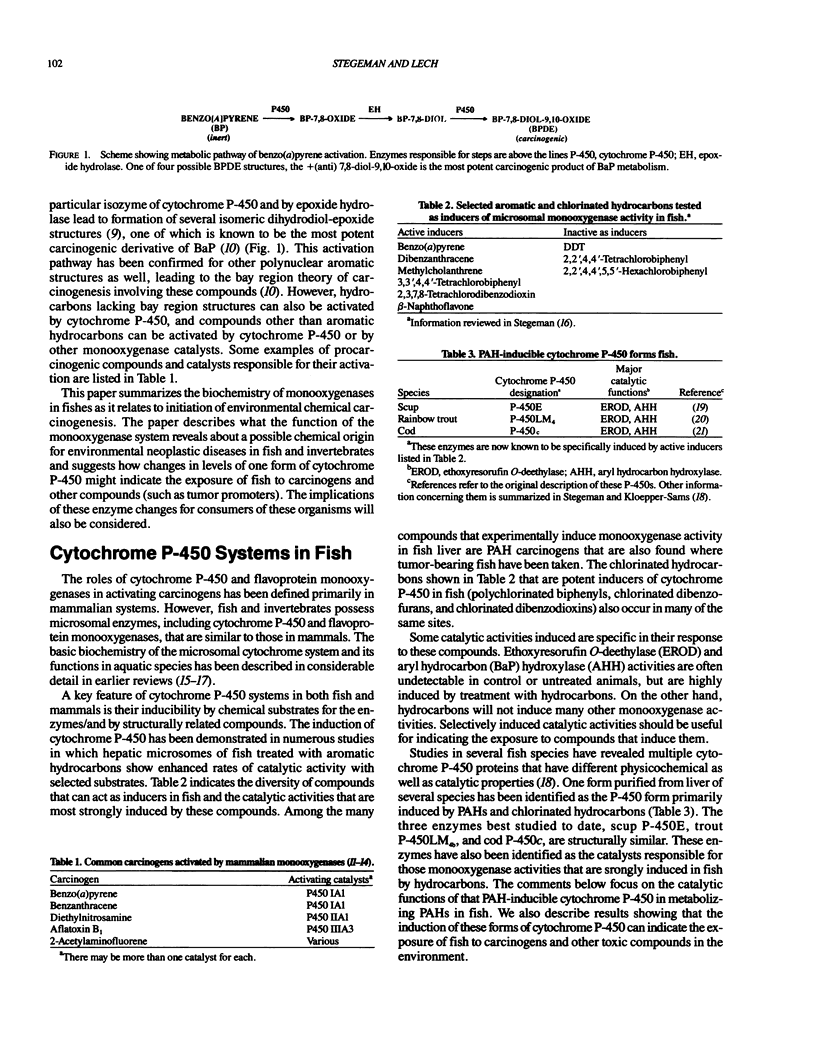
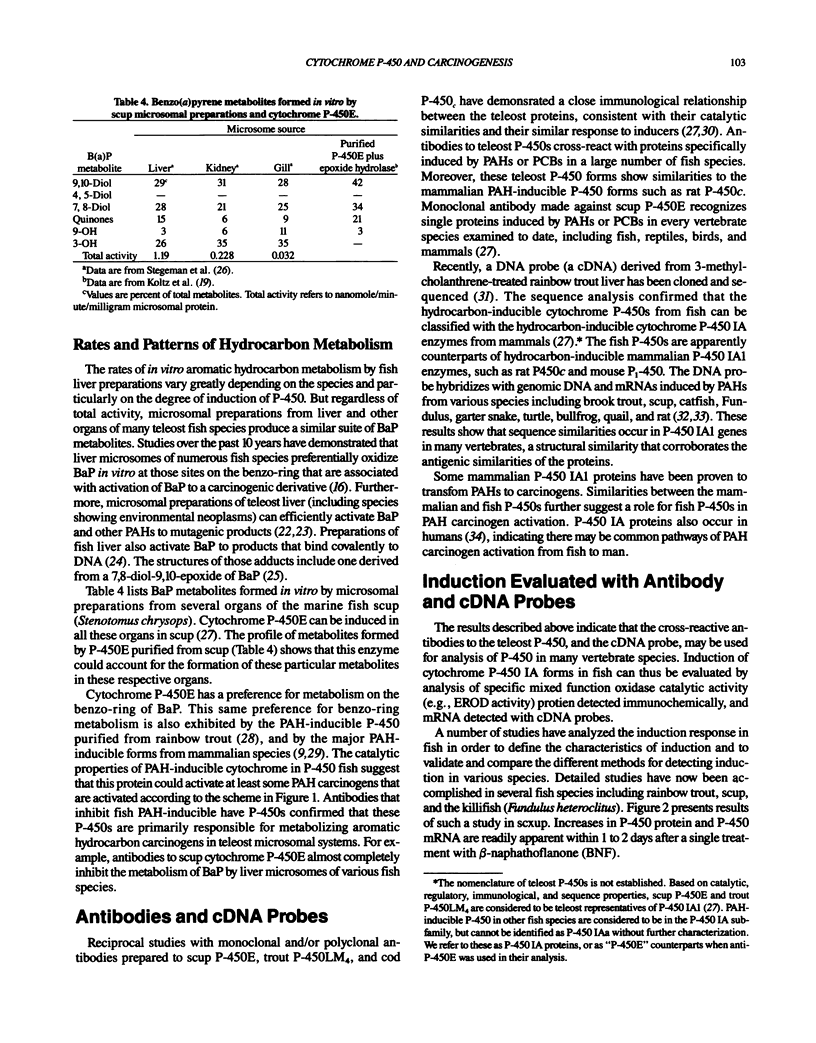
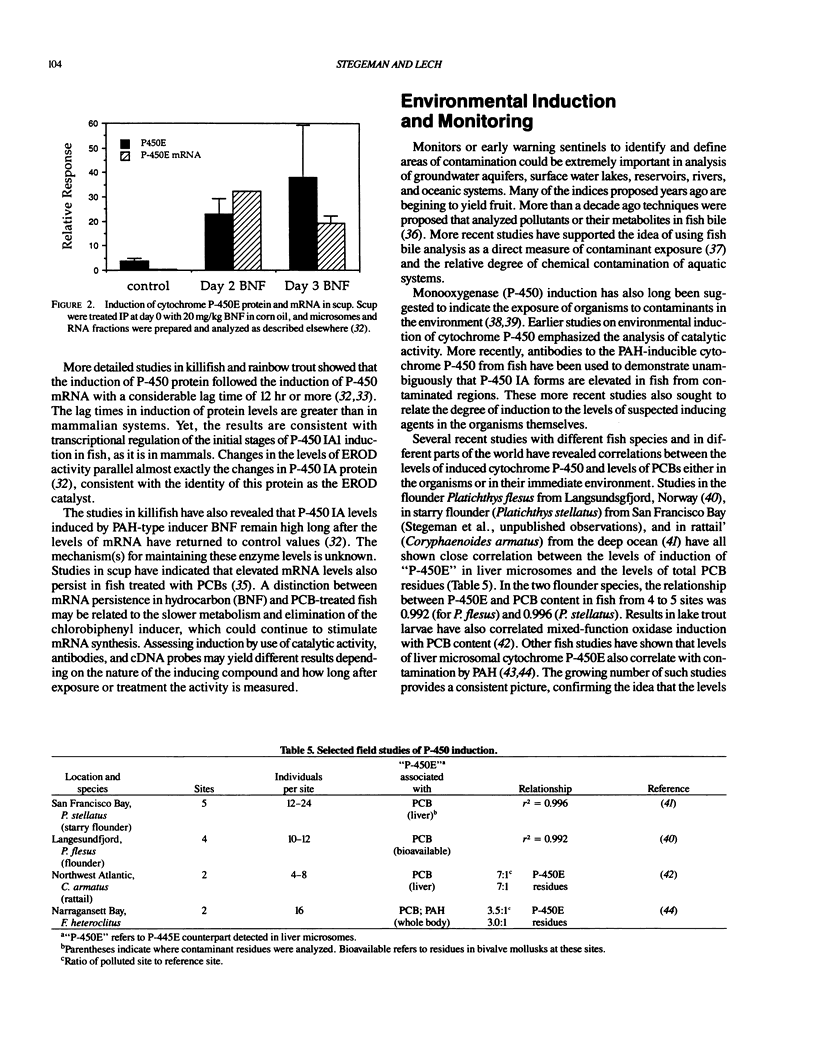
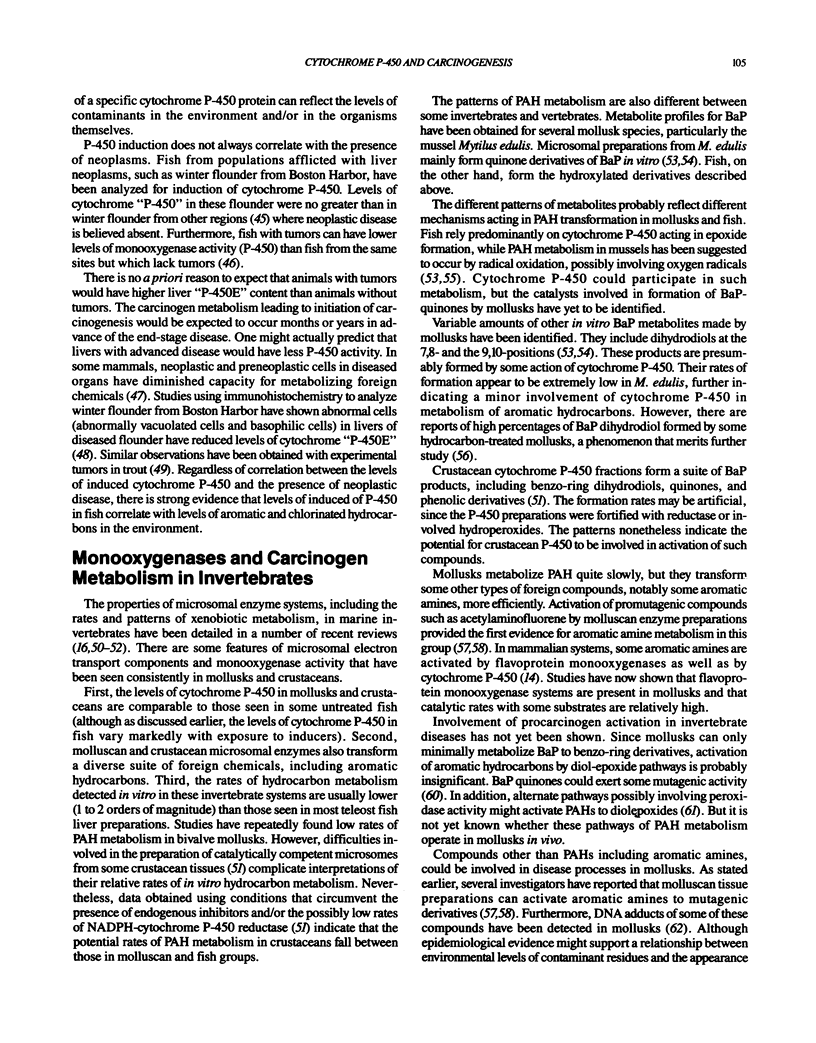
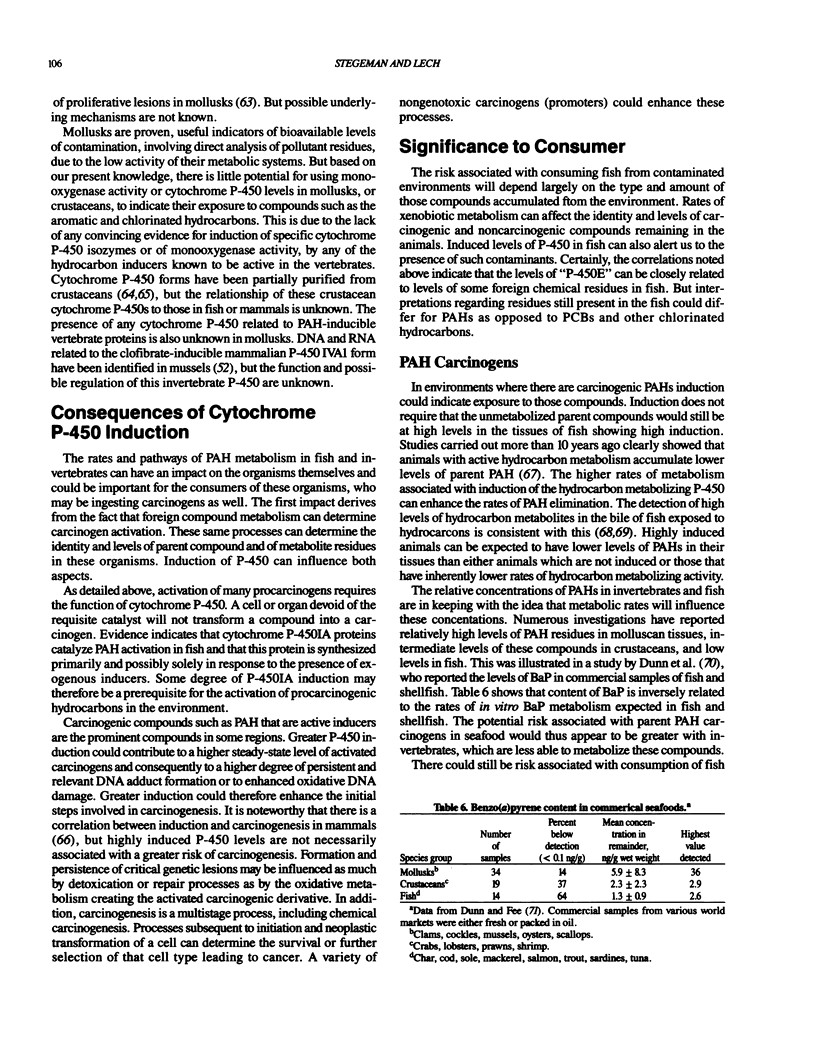
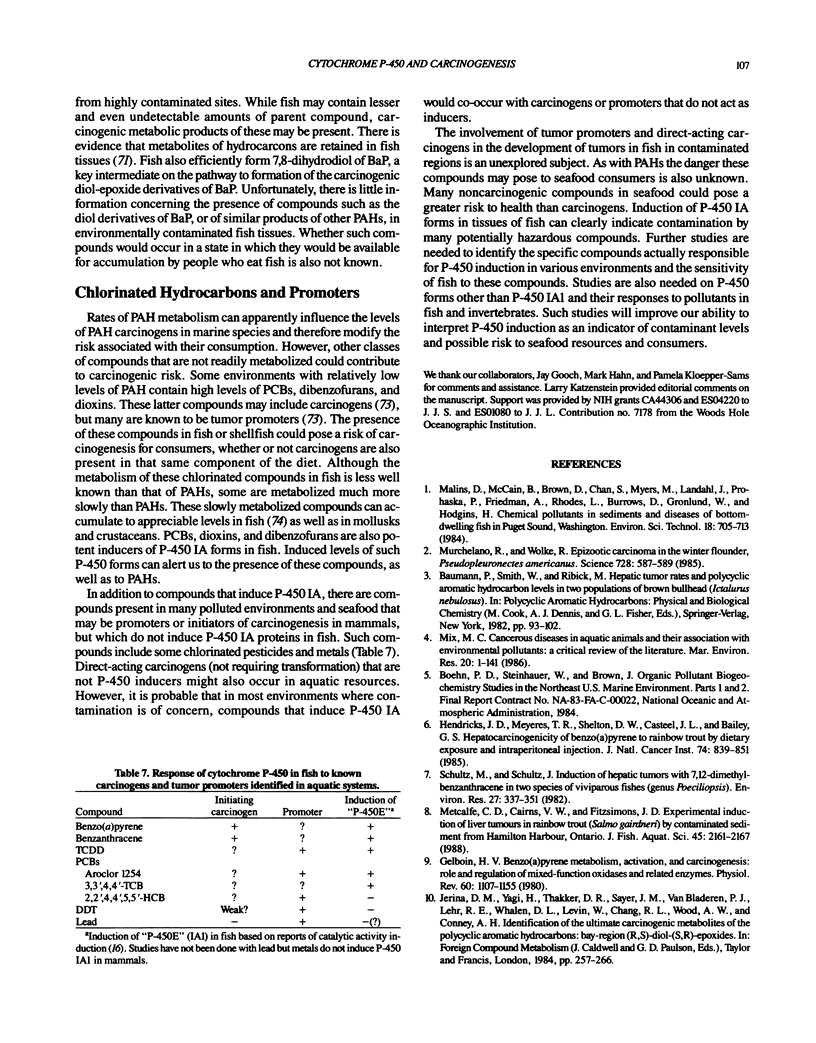
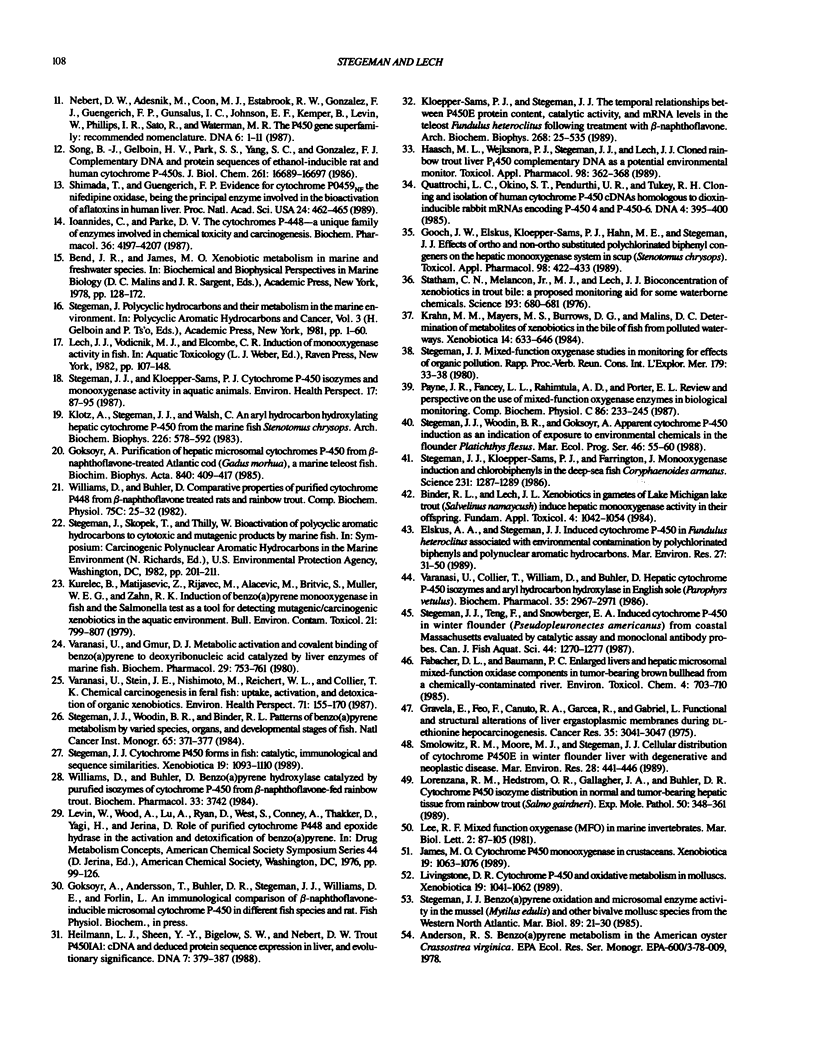
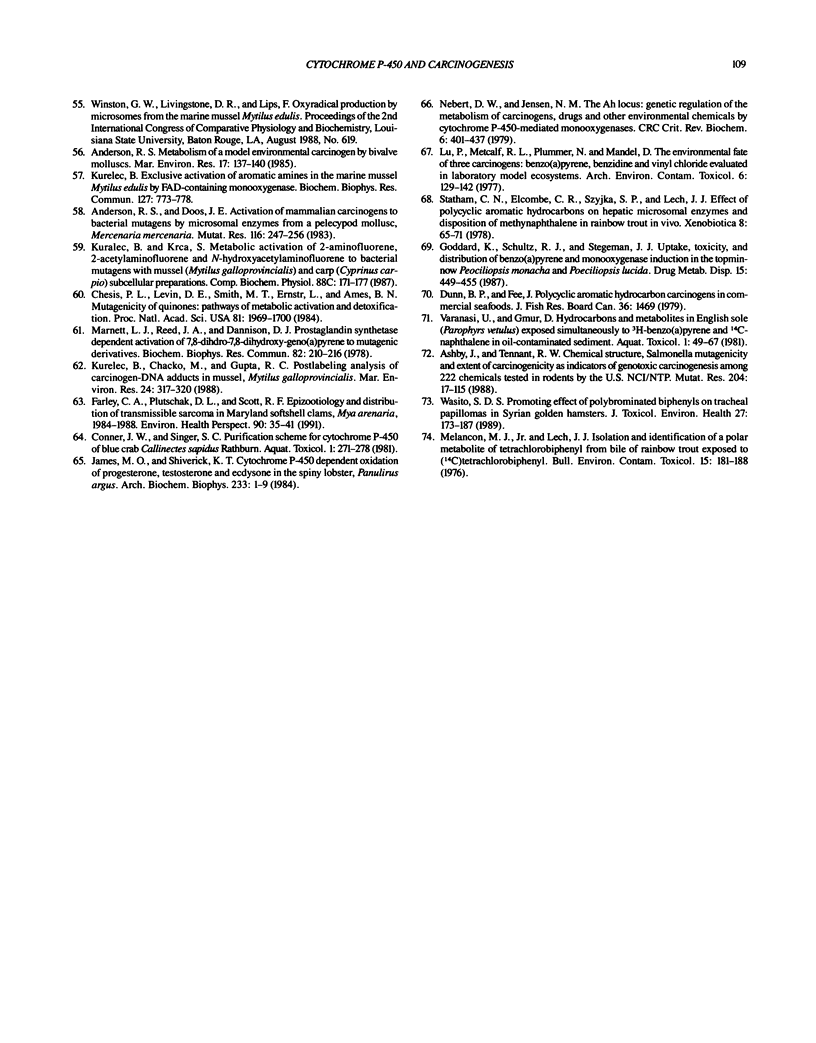
Selected References
These references are in PubMed. This may not be the complete list of references from this article.
- Anderson R. S., Dös J. E. Activation of mammalian carcinogens to bacterial mutagens by microsomal enzymes from a pelecypod mollusk, Mercenaria mercenaria. Mutat Res. 1983 Mar;116(3-4):247–256. doi: 10.1016/0165-1218(83)90062-9. [DOI] [PubMed] [Google Scholar]
- Ashby J., Tennant R. W. Chemical structure, Salmonella mutagenicity and extent of carcinogenicity as indicators of genotoxic carcinogenesis among 222 chemicals tested in rodents by the U.S. NCI/NTP. Mutat Res. 1988 Jan;204(1):17–115. doi: 10.1016/0165-1218(88)90114-0. [DOI] [PubMed] [Google Scholar]
- Binder R. L., Lech J. J. Xenobiotics in gametes of Lake Michigan lake trout (Salvelinus namaycush) induce hepatic monooxygenase activity in their offspring. Fundam Appl Toxicol. 1984 Dec;4(6):1042–1054. doi: 10.1016/0272-0590(84)90244-6. [DOI] [PubMed] [Google Scholar]
- Chesis P. L., Levin D. E., Smith M. T., Ernster L., Ames B. N. Mutagenicity of quinones: pathways of metabolic activation and detoxification. Proc Natl Acad Sci U S A. 1984 Mar;81(6):1696–1700. doi: 10.1073/pnas.81.6.1696. [DOI] [PMC free article] [PubMed] [Google Scholar]
- Farley C. A., Plutschak D. L., Scott R. F. Epizootiology and distribution of transmissible sarcoma in Maryland softshell clams, Mya arenaria, 1984-1988. Environ Health Perspect. 1991 Jan;90:35–41. doi: 10.1289/ehp.90-1519504. [DOI] [PMC free article] [PubMed] [Google Scholar]
- Gelboin H. V. Benzo[alpha]pyrene metabolism, activation and carcinogenesis: role and regulation of mixed-function oxidases and related enzymes. Physiol Rev. 1980 Oct;60(4):1107–1166. doi: 10.1152/physrev.1980.60.4.1107. [DOI] [PubMed] [Google Scholar]
- Goddard K. A., Schultz R. J., Stegeman J. J. Uptake, toxicity, and distribution of benzo[a]pyrene and monooxygenase induction in the topminnows Poeciliopsis monacha and Poeciliopsis lucida. Drug Metab Dispos. 1987 Jul-Aug;15(4):449–455. [PubMed] [Google Scholar]
- Goksøyr A. Purification of hepatic microsomal cytochromes P-450 from beta-naphthoflavone-treated Atlantic cod (Gadus morhua), a marine teleost fish. Biochim Biophys Acta. 1985 Jul 5;840(3):409–417. [PubMed] [Google Scholar]
- Gooch J. W., Elskus A. A., Kloepper-Sams P. J., Hahn M. E., Stegeman J. J. Effects of ortho- and non-ortho-substituted polychlorinated biphenyl congeners on the hepatic monooxygenase system in scup (Stenotomus chrysops). Toxicol Appl Pharmacol. 1989 May;98(3):422–433. doi: 10.1016/0041-008x(89)90171-3. [DOI] [PubMed] [Google Scholar]
- Gravela E., Feo F., Canuto R. A., Garcea R., Gabriel L. Functional and structural alterations of liver ergastoplasmic membranes during DL-ethionine hepatocarcinogenesis. Cancer Res. 1975 Nov;35(11 Pt 1):3041–3047. [PubMed] [Google Scholar]
- Haasch M. L., Wejksnora P. J., Stegeman J. J., Lech J. J. Cloned rainbow trout liver P(1)450 complementary DNA as a potential environmental monitor. Toxicol Appl Pharmacol. 1989 Apr;98(2):362–368. doi: 10.1016/0041-008x(89)90240-8. [DOI] [PubMed] [Google Scholar]
- Heilmann L. J., Sheen Y. Y., Bigelow S. W., Nebert D. W. Trout P450IA1: cDNA and deduced protein sequence, expression in liver, and evolutionary significance. DNA. 1988 Jul-Aug;7(6):379–387. doi: 10.1089/dna.1.1988.7.379. [DOI] [PubMed] [Google Scholar]
- Hendricks J. D., Meyers T. R., Shelton D. W., Casteel J. L., Bailey G. S. Hepatocarcinogenicity of benzo[a]pyrene to rainbow trout by dietary exposure and intraperitoneal injection. J Natl Cancer Inst. 1985 Apr;74(4):839–851. [PubMed] [Google Scholar]
- Ioannides C., Parke D. V. The cytochromes P-448--a unique family of enzymes involved in chemical toxicity and carcinogenesis. Biochem Pharmacol. 1987 Dec 15;36(24):4197–4207. doi: 10.1016/0006-2952(87)90659-9. [DOI] [PubMed] [Google Scholar]
- James M. O., Shiverick K. T. Cytochrome P-450-dependent oxidation of progesterone, testosterone, and ecdysone in the spiny lobster, Panulirus argus. Arch Biochem Biophys. 1984 Aug 15;233(1):1–9. doi: 10.1016/0003-9861(84)90595-2. [DOI] [PubMed] [Google Scholar]
- Kloepper-Sams P. J., Stegeman J. J. The temporal relationships between P450E protein content, catalytic activity, and mRNA levels in the teleost Fundulus heteroclitus following treatment with beta-naphthoflavone. Arch Biochem Biophys. 1989 Feb 1;268(2):525–535. doi: 10.1016/0003-9861(89)90319-6. [DOI] [PubMed] [Google Scholar]
- Klotz A. V., Stegeman J. J., Walsh C. An aryl hydrocarbon hydroxylating hepatic cytochrome P-450 from the marine fish Stenotomus chrysops. Arch Biochem Biophys. 1983 Oct 15;226(2):578–592. doi: 10.1016/0003-9861(83)90327-2. [DOI] [PubMed] [Google Scholar]
- Krahn M. M., Myers M. S., Burrows D. G., Malins D. C. Determination of metabolites of xenobiotics in the bile of fish from polluted waterways. Xenobiotica. 1984 Aug;14(8):633–646. doi: 10.3109/00498258409151461. [DOI] [PubMed] [Google Scholar]
- Kurelec B., Matijasevic Z., Rijavec M., Alacevic M., Britvic S., Müller W. E., Zahn R. K. Induction of benzo (a)pyrene monooxygenase in fish and the Salmonella test as a tool for detecting mutagenic/carcinogenic xenobiotics in the aquatic environment. Bull Environ Contam Toxicol. 1979 Apr;21(6):799–807. doi: 10.1007/BF01685508. [DOI] [PubMed] [Google Scholar]
- Livingstone D. R., Kirchin M. A., Wiseman A. Cytochrome P-450 and oxidative metabolism in molluscs. Xenobiotica. 1989 Oct;19(10):1041–1062. doi: 10.3109/00498258909043161. [DOI] [PubMed] [Google Scholar]
- Lorenzana R. M., Hedstrom O. R., Gallagher J. A., Buhler D. R. Cytochrome P450 isozyme distribution in normal and tumor-bearing hepatic tissue from rainbow trout (Salmo gairdneri). Exp Mol Pathol. 1989 Jun;50(3):348–361. doi: 10.1016/0014-4800(89)90044-0. [DOI] [PubMed] [Google Scholar]
- Lu P. Y., Metcalf R. L., Plummer N., Mandel D. The Environmental fate of three carcinogens: benzo-(alpha)-pyrene, benzidine, and vinyl chloride evaluated in laboratory model ecosystems. Arch Environ Contam Toxicol. 1977;6(2-3):129–142. doi: 10.1007/BF02097756. [DOI] [PubMed] [Google Scholar]
- Marnett L. J., Reed G. A., Dennison D. J. Prostaglandin synthetase dependent activation of 7,8-dihydro-7,8-dihydroxy-geno (a) pyrene to mutagenic derivativies. Biochem Biophys Res Commun. 1978 May 15;82(1):210–216. doi: 10.1016/0006-291x(78)90597-1. [DOI] [PubMed] [Google Scholar]
- Melancon M. J., Jr, Lech J. J. Isolation and identification of a polar metabolite of tetrachlorobiphenyl from bile of rainbow trout exposed to 14C-tetrachlorobiphenyl. Bull Environ Contam Toxicol. 1976 Feb;15(2):181–188. doi: 10.1007/BF01685158. [DOI] [PubMed] [Google Scholar]
- Nebert D. W., Adesnik M., Coon M. J., Estabrook R. W., Gonzalez F. J., Guengerich F. P., Gunsalus I. C., Johnson E. F., Kemper B., Levin W. The P450 gene superfamily: recommended nomenclature. DNA. 1987 Feb;6(1):1–11. doi: 10.1089/dna.1987.6.1. [DOI] [PubMed] [Google Scholar]
- Nebert D. W., Jensen N. M. The Ah locus: genetic regulation of the metabolism of carcinogens, drugs, and other environmental chemicals by cytochrome P-450-mediated monooxygenases. CRC Crit Rev Biochem. 1979;6(4):401–437. doi: 10.3109/10409237909105427. [DOI] [PubMed] [Google Scholar]
- Payne J. F., Fancey L. L., Rahimtula A. D., Porter E. L. Review and perspective on the use of mixed-function oxygenase enzymes in biological monitoring. Comp Biochem Physiol C. 1987;86(2):233–245. doi: 10.1016/0742-8413(87)90074-0. [DOI] [PubMed] [Google Scholar]
- Quattrochi L. C., Okino S. T., Pendurthi U. R., Tukey R. H. Cloning and isolation of human cytochrome P-450 cDNAs homologous to dioxin-inducible rabbit mRNAs encoding P-450 4 and P-450 6. DNA. 1985 Oct;4(5):395–400. doi: 10.1089/dna.1985.4.395. [DOI] [PubMed] [Google Scholar]
- Schultz M. E., Schultz R. J. Induction of hepatic tumors with 7,12-dimethylbenz[a]anthracene in two species of viviparous fishes (Genus poeciliopsis). Environ Res. 1982 Apr;27(2):337–351. doi: 10.1016/0013-9351(82)90089-5. [DOI] [PubMed] [Google Scholar]
- Song B. J., Gelboin H. V., Park S. S., Yang C. S., Gonzalez F. J. Complementary DNA and protein sequences of ethanol-inducible rat and human cytochrome P-450s. Transcriptional and post-transcriptional regulation of the rat enzyme. J Biol Chem. 1986 Dec 15;261(35):16689–16697. [PubMed] [Google Scholar]
- Statham C. N., Elcombe C. R., Szyjka S. P., Lech J. J. Effect of polycyclic aromatic hydrocarbons on hepatic microsomal enzymes and disposition of methylnaphthalene in rainbow trout in vivo. Xenobiotica. 1978 Feb;8(2):65–71. doi: 10.3109/00498257809060385. [DOI] [PubMed] [Google Scholar]
- Statham C. N., Melancon M. J., Jr, Lech J. J. Bioconcentration of xenobiotics in trout bile: a proposed monitoring aid for some waterborne chemicals. Science. 1976 Aug 20;193(4254):680–681. doi: 10.1126/science.948743. [DOI] [PubMed] [Google Scholar]
- Stegeman J. J. Cytochrome P450 forms in fish: catalytic, immunological and sequence similarities. Xenobiotica. 1989 Oct;19(10):1093–1110. doi: 10.3109/00498258909043164. [DOI] [PubMed] [Google Scholar]
- Stegeman J. J., Kloepper-Sams P. J. Cytochrome P-450 isozymes and monooxygenase activity in aquatic animals. Environ Health Perspect. 1987 Apr;71:87–95. doi: 10.1289/ehp.877187. [DOI] [PMC free article] [PubMed] [Google Scholar]
- Stegeman J. J., Kloepper-Sams P. J., Farrington J. W. Monooxygenase Induction and Chlorobiphenyls in the Deep-Sea Fish Coryphaenoides armatus. Science. 1986 Mar 14;231(4743):1287–1289. doi: 10.1126/science.231.4743.1287. [DOI] [PubMed] [Google Scholar]
- Stegeman J. J., Woodin B. R., Binder R. L. Patterns of benzo[a]pyrene metabolism by varied species, organs, and developmental stages of fish. Natl Cancer Inst Monogr. 1984 May;65:371–377. [PubMed] [Google Scholar]
- Varanasi U., Collier T. K., Williams D. E., Buhler D. R. Hepatic cytochrome P-450 isozymes and aryl hydrocarbon hydroxylase in English sole (Parophrys vetulus). Biochem Pharmacol. 1986 Sep 1;35(17):2967–2971. doi: 10.1016/0006-2952(86)90494-6. [DOI] [PubMed] [Google Scholar]
- Varanasi U., Stein J. E., Nishimoto M., Reichert W. L., Collier T. K. Chemical carcinogenesis in feral fish: uptake, activation, and detoxication of organic xenobiotics. Environ Health Perspect. 1987 Apr;71:155–170. doi: 10.1289/ehp.8771155. [DOI] [PMC free article] [PubMed] [Google Scholar]
- Wasito, Sleight S. D. Promoting effect of polybrominated biphenyls on tracheal papillomas in Syrian golden hamsters. J Toxicol Environ Health. 1989;27(2):173–187. doi: 10.1080/15287398909531289. [DOI] [PubMed] [Google Scholar]


